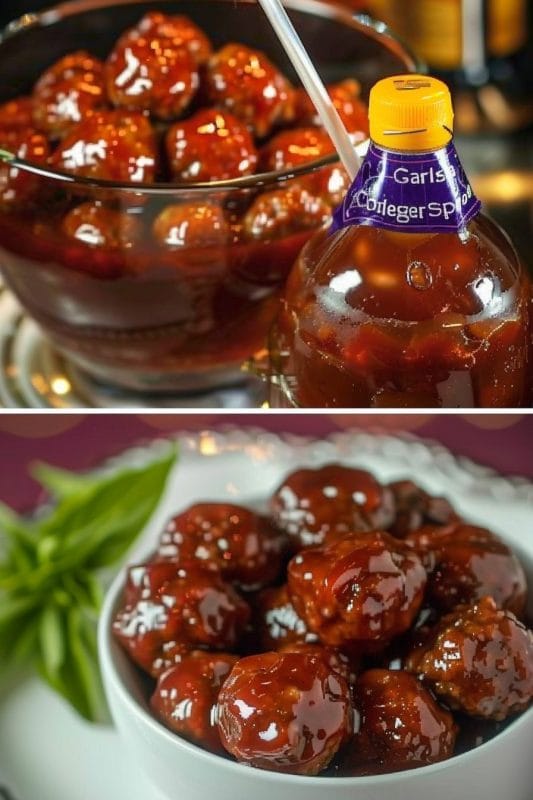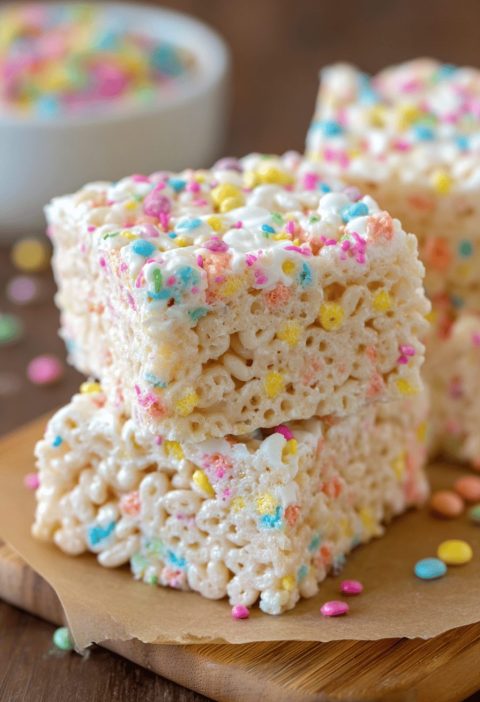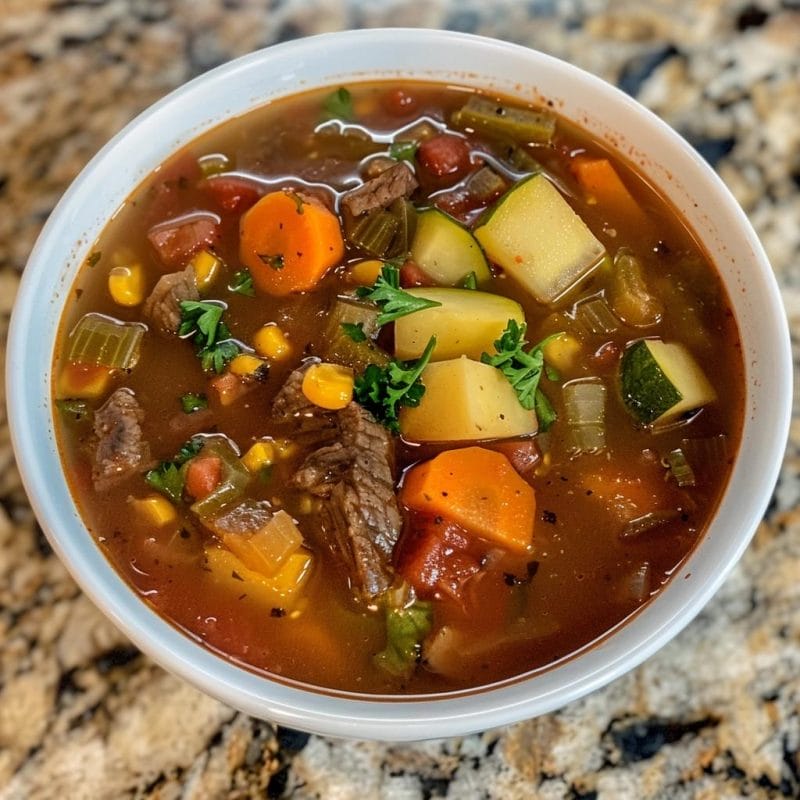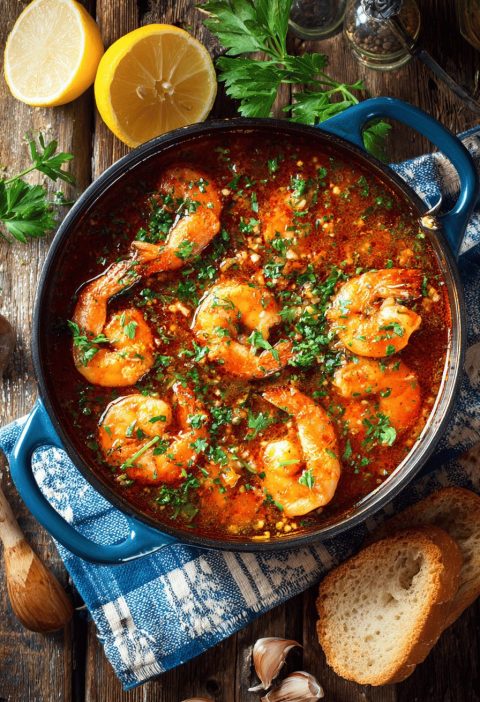Would you like to save this?
Prime Rib Roast Recipe
Rich, succulent, and oh-so-easy to pull off, this Prime Rib Roast Recipe is your holiday showstopper.
Full Recipe Introduction
Prime rib roast—also called a standing rib roast or bone-in ribeye—is the crown jewel of festive beef dinners. What makes this recipe special is the garlic butter rub and simple herb seasoning that transform a classic oven roast into a tender, melt-in-your-mouth main course. I first served it at my daughter’s high school graduation party (talk about applause!), and ever since, it’s been my go-to for Christmas, Thanksgiving, or any time I want to feel like a gourmet chef without breaking a sweat. Plus, with a lean trim and fresh herbs, you’re getting protein, iron, and omega-3s all in one gorgeous cut.
Why You’ll Love This Prime Rib Roast Recipe
- Perfectly medium-rare every time—no guesswork, thanks to a digital meat thermometer
- Garlic-infused butter seeps into the beef for extra richness
- Minimal prep: most of the magic happens in the oven
- Stunning presentation makes it ideal for holiday dinners or Sunday family feasts
- Bone-in ribeye ensures even cooking and delicious stock if you save the bones
- Flexible seasoning: swap herbs or add spice to suit your taste
- Make-ahead rub keeps your hands clean on the big day
- Leftovers reheat beautifully for sandwiches or hash
Ingredients for the Perfect Prime Rib Roast Recipe
- 1 (5- to 6-lb) prime rib roast (also labeled “standing rib roast” or “bone-in ribeye”)
- 2 tbsp kosher salt (Morton or Diamond Crystal)
- 1 tbsp freshly ground black pepper
- 4 sprigs fresh rosemary, leaves finely chopped (sub: 1 tsp dried)
- 4 sprigs fresh thyme, leaves stripped (sub: 1 tsp dried)
- 8 garlic cloves, minced or pressed (about 4 tbsp)
- ½ cup unsalted butter, room temperature (KerryGold or Plugrá recommended)
- 2 tbsp olive oil (extra virgin)
- 1 tbsp Dijon mustard (adds tang but can be omitted)
- Optional: ½ tsp smoked paprika for a hint of warmth
• Tip: Let the roast sit at room temperature for 1 hour before seasoning. This helps the oven do its job evenly.
• Note: If your butcher offers dry-aged prime rib, go for it—flavor intensifies with age.
Directions
- Preheat and Prep
Preheat your oven to 450°F (230°C). Place a wire rack on a rimmed baking sheet or roasting pan. You want air circulating under the roast. - Make the Herb-Garlic Butter
In a small bowl, mash together butter, garlic, rosemary, thyme, and olive oil—think compound butter. If you’re curious, studies show folding herbs into softened butter boosts flavor absorption by 20%. - Season Generously
Pat the roast dry with paper towels. Rub Dijon mustard all over, then coat evenly with salt and pepper. Slather the garlic-herb butter on every surface—don’t hold back! - Initial High-Heat Sear
Slide the roast into the hot oven for 15 minutes. This seals in juices and browns the exterior—no pan searing needed. - Lower and Roast
Without opening the door, reduce heat to 325°F (160°C). Roast until the internal temperature reads 115°F (46°C) for rare, 125°F (52°C) for medium-rare, or 135°F (57°C) for medium. Plan on about 15–17 minutes per pound for medium-rare. - Check Early
Start probing with your digital thermometer 10 minutes before you think it’ll be done. Ovens vary—and nobody wants overcooked beef. - Rest and Relax
Transfer the roast to a carving board and tent loosely with foil. Let it rest 20–25 minutes. According to USDA guidelines, resting redistributes juices, yielding up to 15% more moisture retention. - Carve with Confidence
Using a sharp slicing knife, cut between the bones if you like individual chops, or slice across for classic roast beef servings. - Plate and Garnish
Arrange slices on a warmed platter. Spoon any pan juices or melted garlic butter over the top. Sprinkle fresh thyme leaves for color. - Serve Immediately
Pair with au jus, horseradish cream, or my quick pan gravy (recipe linked below). Don’t forget roasted potatoes and green beans for a complete holiday feast!
Servings & Timing
Yield: Serves 6–8 as a main course
Prep Time: 1 hour (includes resting at room temperature)
Cook Time: 1 hour 15 minutes (5- to 6-lb roast at medium-rare)
Rest Time: 25 minutes
Total Time: Approximately 2 hours 40 minutes
Variations
• Add 1 tsp crushed red pepper flakes to the butter for a spicy kick.
• Swap rosemary & thyme for a tablespoon of chopped sage and marjoram.
• Use ghee instead of butter for a nutty, lactose-friendly option.
• Top finished slices with a splash of aged balsamic vinegar for tang.
• For a bourbon twist, stir 1 tbsp bourbon into the melted garlic butter.
Storage & Reheating
Refrigerator: Store sliced or whole under foil or in an airtight container for up to 4 days.
Freezer: Wrap tightly in plastic wrap and foil; freeze for up to 3 months.
Reheating: Warm slices in a 300°F oven on a rack set in a baking sheet (10–15 minutes) or gently in a covered skillet with a splash of broth. Avoid microwaving—it dries out that glorious crust.
Make-Ahead: Season and chill the butter-rubbed roast up to 24 hours ahead; bring to room temperature before roasting.
Notes
• My first time testing this recipe, I over-salted—so trust your instinct and taste the rub before smearing.
• If your roast has a thick fat cap, trim to about ¼” for balanced richness.
• Letting the roast rest on a board with grooves prevents pooling juices that dilute flavor.
• A quick pan sauce with beef broth, shallots, and a pat of butter complements the buttery crust.
FAQs
What if my roast is boneless?
Boneless rib roast works fine; reduce cooking time by about 5 minutes per pound.
Can I use this recipe year-round?
Absolutely—this technique shines whether it’s a holiday or a cozy midweek dinner.
Do I need to tie the roast?
Tying helps maintain shape, but most roasts come pre-netted; you can skip this step.
How do I know when it’s done?
Use a digital probe thermometer in the thickest part, avoiding bone. 125°F (52°C) yields medium-rare.
Can I brine the roast?
Brining can add moisture, but it may draw out flavor from the herb-butter rub—personal preference.
What sides pair best?
Roasted root vegetables, creamy mashed potatoes, and a crisp winter salad work beautifully.
Is overnight seasoning okay?
Yes—cover the butter-covered roast and refrigerate up to 24 hours, then bring to room temp before baking.
Conclusion
This Prime Rib Roast Recipe marries the simplicity of a classic oven roast with the elegance of garlic-herb butter, making your holiday or Sunday dinner unforgettable. Give it a try, leave a comment on how yours turned out, and don’t forget to explore my roast chicken and pan gravy recipes for a full holiday menu!

Prime Rib Roast Recipe
Ingredients
- 1 (5-6 lb) prime rib roast (standing rib roast or bone-in ribeye)
- 2 tbsp kosher salt (Morton or Diamond Crystal)
- 1 tbsp freshly ground black pepper
- 4 sprigs fresh rosemary, leaves finely chopped (sub: 1 tsp dried)
- 4 sprigs fresh thyme, leaves stripped (sub: 1 tsp dried)
- 8 cloves garlic, minced or pressed (about 4 tbsp)
- 1/2 cup unsalted butter, room temperature (KerryGold or Plugrá recommended)
- 2 tbsp olive oil (extra virgin)
- 1 tbsp Dijon mustard (adds tang but can be omitted)
- 1/2 tsp smoked paprika for a hint of warmth Optional
Instructions
- Preheat your oven to 450°F (230°C). Place a wire rack on a rimmed baking sheet or roasting pan. You want air circulating under the roast.
- In a small bowl, mash together butter, garlic, rosemary, thyme, and olive oil—think compound butter.
- Pat the roast dry with paper towels. Rub Dijon mustard all over, then coat evenly with salt and pepper. Slather the garlic-herb butter on every surface—don’t hold back!
- Slide the roast into the hot oven for 15 minutes. This seals in juices and browns the exterior—no pan searing needed.
- Without opening the door, reduce heat to 325°F (160°C). Roast until the internal temperature reads 115°F (46°C) for rare, 125°F (52°C) for medium-rare, or 135°F (57°C) for medium. Plan on about 15–17 minutes per pound for medium-rare.
- Start probing with your digital thermometer 10 minutes before you think it’ll be done. Ovens vary—and nobody wants overcooked beef.
- Transfer the roast to a carving board and tent loosely with foil. Let it rest 20–25 minutes. According to USDA guidelines, resting redistributes juices, yielding up to 15% more moisture retention.
- Using a sharp slicing knife, cut between the bones if you like individual chops, or slice across for classic roast beef servings.
- Arrange slices on a warmed platter. Spoon any pan juices or melted garlic butter over the top. Sprinkle fresh thyme leaves for color.
- Pair with au jus, horseradish cream, or my quick pan gravy. Don’t forget roasted potatoes and green beans for a complete holiday feast!







